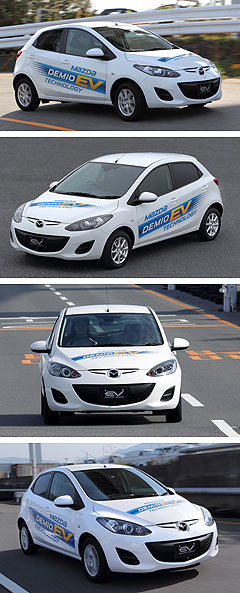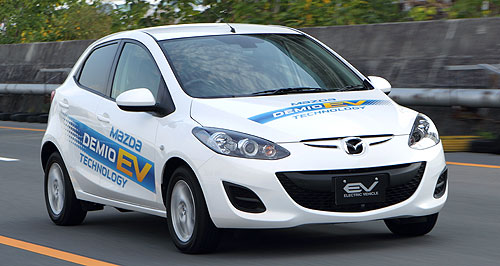Make / Model Search
Future models - Mazda - Mazda2 - EVFirst drive: Mazda electrifiesHighly charged: Mazda claims its Demio electric vehicle will offer a relatively lengthy driving range of 200km. Mazda2 EV combines spirited performance with longer-range zero-emissions motoring5 Dec 2011 By MARTON PETTENDY in JAPAN MAZDA says its first electric vehicle has exceeded the company’s zero exhaust-emissions driving range target of at least 200km before it becomes available for lease in Japan next year as a precursor to other future EVs from the Japanese brand. However, final validation testing of the Mazda2 EV, which has not been confirmed for retail sale inside or outside of Japan, is yet to be completed and Mazda will not reveal full performance or battery details for its Japanese domestic-market Demio-based vehicle for competitive reasons. Despite that, GoAuto can confirm the Mazda2 EV – at least 100 of which will be produced for Japanese government and corporate lessees in 2012 – offers an outstanding level of performance, refinement and integration after we were among the world’s first global media outlets to drive the mould-breaking Mazda at its Hiroshima headquarters last week. Mazda’s inaugural EV, which has been under development since mid-2010, previews the final step in the company’s ‘building block’ approach to cutting its fleet-average fuel consumption by 30 per cent between 2008 and 2015. Before it releases its first EV, however, Mazda will launch its first hybrid model in Japan in 2013, and says its rollout of SkyActiv models – starting early next year with the all-new CX-5 compact SUV, which previews a new range of lightweight bodies and more efficient petrol and diesel engines – will have a far greater impact on total global CO2 reduction.  Mazda will not say exactly when its first EV will become available to private customers, but concedes it will be well before 2017, when strict new corporate average fuel consumption (CAFE) legislation – and even tighter fleet-average CO2 limits in certain ‘green’ states of the US – comes into effect. Mazda will not say exactly when its first EV will become available to private customers, but concedes it will be well before 2017, when strict new corporate average fuel consumption (CAFE) legislation – and even tighter fleet-average CO2 limits in certain ‘green’ states of the US – comes into effect.“We have so far worked on IC (internal combustion engine) development, but we are now looking at a new phase of the market and an environment (in which) we need to produce zero emissions,” said Mazda Motor Corporation EV program manager Mitsuru Fujinaka. “Yes, I hope to be able to do that (produce an EV for public release) in the future. The EV regulations will become more stringent in green states of the US and we assume that from the 2018 model year … but we are trying to be ready earlier than that. “Sooner or later, we will have to have EVs or we won’t be able to sell (cars at all).” Mazda will not name the supplier of the Mazda2 EV’s most important and heaviest single component, but Mr Fujinaka confirmed it would have a lithium-ion battery with an output of at least 20kWh. Charging time will be seven to eight hours via a standard 200-volt Japanese power outlet, or in just half an hour using a higher-voltage quick-charge outlet. He said the Demio EV would offer a claimed operating range of more than 200km. This is better than Mitsubishi’s pioneering i-MiEV, Nissan’s upcoming Leaf and the plug-in hybrid Volt due from GM/Holden in Australia late next year – all of which offer about 160km – but less than the lease-only Mini E (240km). “We are still developing the car, so we cannot talk about details … Yes, I think we can go beyond that (200km), but depends on the battery performance. We have hit the target, but still need to validate the battery reliability.” The battery pack is bolted underneath the floorpan and also fills the space underneath the rear seat, replacing the fuel tank and slightly reducing ground clearance but leaving the boot, cabin, body and chassis fundamentally unchanged. Similarly, the drive motor and power controller fill the void vacated by the engine and transmission under the bonnet, and continue to drive the front wheels. Because the battery and motor add about 100kg of extra mass, the electrified Mazda2 hatch rides on modified suspension and feels heavier to turn into corners than the standard petrol-powered Mazda light car, which feels lighter on its feet and more willing to change direction. On Mazda’s 2km Hiroshima test track, however, the electrified Two was a revelation in terms of performance, delivering a crisp, responsive wave of torque – anywhere from standstill to beyond 100km/h – that makes the smaller i-MiEV and larger Leaf feel decidedly pedestrian in comparison. The pint-sized EV’s effortless, seamless acceleration squashes you into the driver’s seat more satisfyingly than any Mazda2 we’ve driven before and is accompanied by an eerily relaxing silence, broken only by the electronic whir of its inverter when full power is called on. Despite the startling throttle response, there is no transmission snatch or driveline coarseness, even under abrupt pedal applications, making the Mazda2 EV feel more refined and production-ready than the Hyundai i10-based BlueOn EV we drove in Korea last year. If fact, Mazda’s direct rival for the Honda Fit (Jazz) EV is as integrated and user-friendly as its donor model, with a Charge/Eco/Power gauge replacing the tacho and a ‘Ready’ symbol illuminating when you turn the conventional key. In addition to a regular Drive mode, the transmission shift gate in the development vehicle we drove featured ‘S’ and ‘L’ modes, but another pre-production version on display offered an ‘Eco’ mode, suggesting the Mazda2 EV will come with a regenerative braking mode like the i-MiEV, offering a greater level of ‘engine’ braking and kinetic energy recovery. After six hard laps or 12km, the Mazda2 EV’s digital display revealed a remaining range of 110km, but we have no reason to question Mazda’s 200km range claim under less demanding driving conditions. Mr Fujinaka said Mazda’s first EV would lead to other full-electric – as well as plug-in hybrid – models from the Japanese brand, potentially including all-wheel-drive and range-extending hydrogen-rotary vehicles. “Yes, we are studying that,” he said. “We haven’t decided on a specific model yet, but we are studying EV for various applications.” Mazda Australia spokesman Steve Maciver said the Demio EV would not appear in local showrooms any time soon and questioned the acceptance of EVs in Australia, where consumers are not offered the kind of federal, state and local government incentives available in other countries. However, he said Mazda Australia would seriously consider any electrified model that became available for the local market, where the popularity of EVs can only grow. “It won’t happen overnight or in the next few years, but if we were to be offered an electric Mazda for sale in Australia it’s something we would look at seriously,” said Mr Maciver. “We’d look at pricing, market demand and where it would fit into the range – the same process we always do. If we can make it add up, there’s no reason it wouldn’t be there. “It’s not a matter of waiting to see what others (brands) are doing, but when it’s available for retail sale in our market. “Having said that, I don’t think the market is quite ready in Australia, and from a production point of view we’re not ready to take it to another level for retail sale.”  Read more2nd of December 2011  Mazda6 hatch to be axedAustralia’s most popular Mazda6 body derivative set to be killed off from 201330th of November 2011  Tokyo show: Takeri previews next Mazda6Mazda reveals full details and images of its sleek new Mazda6-teasing Takeri concept30th of November 2011  Mazda plotting rotary coupeRotary engine to live on under the bonnet of a new Mazda coupe to replace RX-8All future modelsMazda2 pricingMotor industry news |
Click to shareMazda modelsResearch Mazda All future modelsMazda2 pricingMotor industry news |



 Alfa Romeo
Alfa Romeo Abarth
Abarth Audi
Audi Aston Martin
Aston Martin BMW
BMW Bentley
Bentley Ferrari
Ferrari Chevrolet
Chevrolet Ford
Ford Fiat
Fiat GWM
GWM Foton
Foton Hyundai
Hyundai Honda
Honda Jaguar
Jaguar Isuzu
Isuzu Kia
Kia Jeep
Jeep Land Rover
Land Rover Lamborghini
Lamborghini Maserati
Maserati Lexus
Lexus McLaren
McLaren Mazda
Mazda Mercedes-Benz
Mercedes-Benz Mitsubishi
Mitsubishi Mini
Mini Peugeot
Peugeot Nissan
Nissan Ram
Ram Porsche
Porsche Rolls-Royce
Rolls-Royce Smart
Smart Skoda
Skoda Suzuki
Suzuki Subaru
Subaru Toyota
Toyota Tesla
Tesla Volvo
Volvo Zeekr
Zeekr







Facebook Twitter Instagram